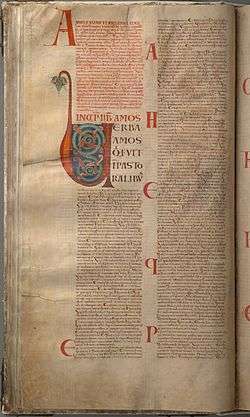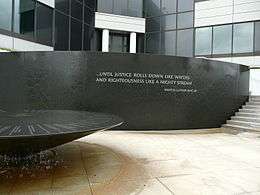Amos 5
Amos 5 is the fifth chapter of the Book of Amos in the Hebrew Bible or the Old Testament of the Christian Bible.[1][2] This book contains the prophecies attributed to the prophet Amos, including a lamentation for Israel, Amos 5:1–3; an exhortation to repentance, Amos 5:4–20; God's rejection to their hypocritical service, Amos 5:21–27.[3] It is a part of the Book of the Twelve Minor Prophets.[4][5]
| Amos 5 | |
|---|---|
 | |
| Book | Book of Amos |
| Category | Nevi'im |
| Christian Bible part | Old Testament |
| Order in the Christian part | 30 |
Text
The original text was written in Hebrew language. This chapter is divided into 27 verses.
Textual witnesses
Some early manuscripts containing the text of this chapter in Hebrew are of the Masoretic Text tradition, which includes the Codex Cairensis (895), the Petersburg Codex of the Prophets (916), Aleppo Codex (10th century), Codex Leningradensis (1008).[6]
Fragments containing parts of this chapter were found among the Dead Sea Scrolls including 4Q82 (4QXIIg; 25 BCE) with extant verses 1–2, 9–18.[7][8][9]
There is also a translation into Koine Greek known as the Septuagint, made in the last few centuries BCE. Extant ancient manuscripts of the Septuagint version include Codex Vaticanus (B; B; 4th century), Codex Alexandrinus (A; A; 5th century) and Codex Marchalianus (Q; Q; 6th century).[10][lower-alpha 1]
Structure
NKJV groups this chapter into:
- Amos 5:1–3 = A Lament for Israel
- Amos 5:4–15 = A Call to Repentance
- Amos 5:16–27 = The Day of the Lord
Verse 24

- But let justice roll down as waters,
- and righteousness as a mighty stream.[12]
Dr. Martin Luther King Jr. cited this verse in his memorable "I Have a Dream" speech (August 28, 1963 in Washington, D.C.).[13][14]
Verse 26
- But ye have borne the tabernacle of your Moloch
- and Chiun your images, the star of your god,
- which ye made to yourselves.[15]
- and Chiun your images, the star of your god,
Verse 26 in Hebrew
Masoretic text:
- ונשאתם את סכות מלככם ואת כיון צלמיכם כוכב אלהיכם אשר עשיתם לכם׃
Transliteration:
- ū-nə-śā-ṯem ’êṯ sik-kūṯ mal-kə-ḵem, wə-’êṯ kî-yūn ṣal-mê-ḵem, kō-w-ḵaḇ ’ĕ-lō-hê-ḵem, ’ă-sher ‘ă-shî-ṯem lā-ḵem.
Verse 26 notes
- "But ye have borne": Literally, "And ye bare the tabernacle of your Moloch" (literally, "your king," from where the idol Moloch had its name.) He assigns the reason, why he had denied that they sacrificed to God in the wilderness. "Did ye offer sacrifices unto Me, and ye bare?" that is, seeing that ye bare. The two were incompatible. Since they did "carry about the tabernacle of their king," they did not really worship God. He whom they chose as "their king," was their god.[16]
- "The tabernacle of your Moloch": τὴν σκηνὴν τοῦ Μολόχ (Septuagint); tabernaculum Moloch vestro (Vulgate). The Hebrew word rendered "tabernacle" (sikkuth). which is found nowhere else, has been variously explained. Aquila gives συσκιασμούς: Theodotion, "vision," reading the whole sentence thus: Καὶ ἤρατε τὴν ὅρασιν τοῦ Θεοῦ ὑμῶν ὑμῶν ἄστρον τοῦ Θεοῦ ὑμῶν. Many moderns render, "stake," "column," or "shrine." Others suppose it to be equivalent to Sakkuth, an Assyrian name for Molech (or Adar); but this is very uncertain (see 'Studien und Kritiken.' 1874, p. 887), sad the parallelism requires the word to be an appellative and not a proper name. It most probably means "shrine," a portable shrine, like those spoken of in Acts 19:24 in connection with the worship of Diana. The Syriac and Arabic versions call it "tent," and thus the reproach stands forth emphatically that, instead of, or in conjunction with, the true tabernacle, they bore aloft, as if proud of their apostasy, the tabernacle of a false god. Such shrines were used by the Egyptians, according to Herodotus (2:63, where see Rawlinson's note) and Diod. Sic. (1:97). Many such may be seen in the Egyptian room of the British Museum. Keil quotes Drumann, 'On the Rosetta Inscription,' p. 211, "These were small chapels, generally gilded and ornamented with flowers and in other ways, intended to hold a small idol when processions were made, and to be carried or driven about with it." Hence we must look to Egypt as the source of this idolatry.[17]
- "The star of your god": R. Isaac Caro says all the astrologers represented Saturn as the star of Israel. Probably there was a figure of a star on the head of the image of the idol, to represent the planet Saturn; hence "images" correspond to "star" in the parallel clause. A star in hieroglyphics represents God (Numbers 24:17). "Images" are either a Hebraism for "image," or refer to the many images made to represent Chiun.[3]
- "Chiun": This is the same with "Chevan", which in the Arabic and Persic languages is the name of "Saturn", as Aben Ezra and Kimchi say; and is so rendered by Montanus here; and who in the Egyptian tongue was called Revan, or Rephan, or Remphan; as by the Septuagint here, and in Acts 7:43; some read it Cavan, and take it to signify a "cake"; in which sense the word is used in Jeremiah 7:18; and render it, "the cake of your images";[18] and supposing that it had the image of their gods impressed upon it. Calmet interprets it "the pedestal of your images";[19] and indeed the word has the signification of a basis, and is so rendered by some;[20] and is applicable to Mo/Moloch their king, a king being the basis and foundation of the kingdom and people; and to the sun, intended by that deity, which is the basis of the celestial bodies, and of all things on earth. Some take Mo and Chiun to be distinct deities, the one to be the sun, the other the moon; but they seem rather to be the same, and both to be the Egyptian ox, and the calf of the Israelites in the wilderness, the image of which was carried in portable tents or tabernacles, in chests or shrines; such as the Succothbenoth, or tabernacles of Venus, 2 Kings 17:30; and those of Diana's, Acts 19:24.[21]
Verse 27
- Therefore will I cause you to go into captivity beyond Damascus,
- saith the Lord, whose name is The God of hosts.[22]
This verse plays an important role in the Damascus Document, an important Essene text from among the Dead Sea Scrolls.[23]
See also
|
|
|
Notes
- The extant Codex Sinaiticus currently does not have the whole Book of Amos.[11]
References
- Collins 2014.
- Hayes 2015.
- Robert Jamieson, Andrew Robert Fausset; David Brown. Jamieson, Fausset, and Brown's Commentary On the Whole Bible. 1871.

- Metzger, Bruce M., et al. The Oxford Companion to the Bible. New York: Oxford University Press, 1993.
- Keck, Leander E. 1996. The New Interpreter's Bible: Volume: VII. Nashville: Abingdon.
- Würthwein 1995, pp. 35-37.
- Ulrich 2010, pp. 605–606.
- Dead sea scrolls – Amos
- Fitzmyer 2008, p. 39.
- Würthwein 1995, pp. 73-74.
-

- Amos 5:24 ASV
- "No, no, we are not satisfied and we will not be satisfied until justice rolls down like waters and righteousness like a mighty stream." "I Have a Dream," Address delivered at the March on Washington for Jobs and Freedom. August 28, 1963. Washington, D.C.
- Bible References in Martin Luther King, Jr.’s “I Have a Dream” Speech. Andy Rau. Bible Gateway. August 28, 2011.
- Amos 5:26
- Barnes, Albert. Notes on the Old Testament. London, Blackie & Son, 1884. Reprint, Grand Rapids: Baker Books, 1998.

- Joseph S. Exell; Henry Donald Maurice Spence-Jones (Editors). The Pulpit Commentary. 23 volumes. First publication: 1890.

- "placentam imagiuum vestrarum", Pagninus, Tigurine version, Vatablus.
- Calmet. Dictionary, in the word "Chiun".
- "Basim imaginum vestrarum", Junius & Tremellius, Piscator; "statumen", Burkius.
- John Gill. John Gill's Exposition of the Entire Bible. Exposition of the Old and New Testament. Published in 1746–1763.

- Amos 5:27
- Samuel Thomas, "Let Justice Roll Down Like Waters", n.p. [cited 30 Jan 2017]. Bible Odyssey.
Sources
- Collins, John J. (2014). Introduction to the Hebrew Scriptures. Fortress Press.CS1 maint: ref=harv (link)
- Fitzmyer, Joseph A. (2008). A Guide to the Dead Sea Scrolls and Related Literature. Grand Rapids, MI: William B. Eerdmans Publishing Company. ISBN 9780802862419.CS1 maint: ref=harv (link)
- Hayes, Christine (2015). Introduction to the Bible. Yale University Press.CS1 maint: ref=harv (link)
- Ulrich, Eugene, ed. (2010). The Biblical Qumran Scrolls: Transcriptions and Textual Variants. Brill.CS1 maint: ref=harv (link)
- Würthwein, Ernst (1995). The Text of the Old Testament. Translated by Rhodes, Erroll F. Grand Rapids, MI: Wm. B. Eerdmans. ISBN 0-8028-0788-7. Retrieved January 26, 2019.